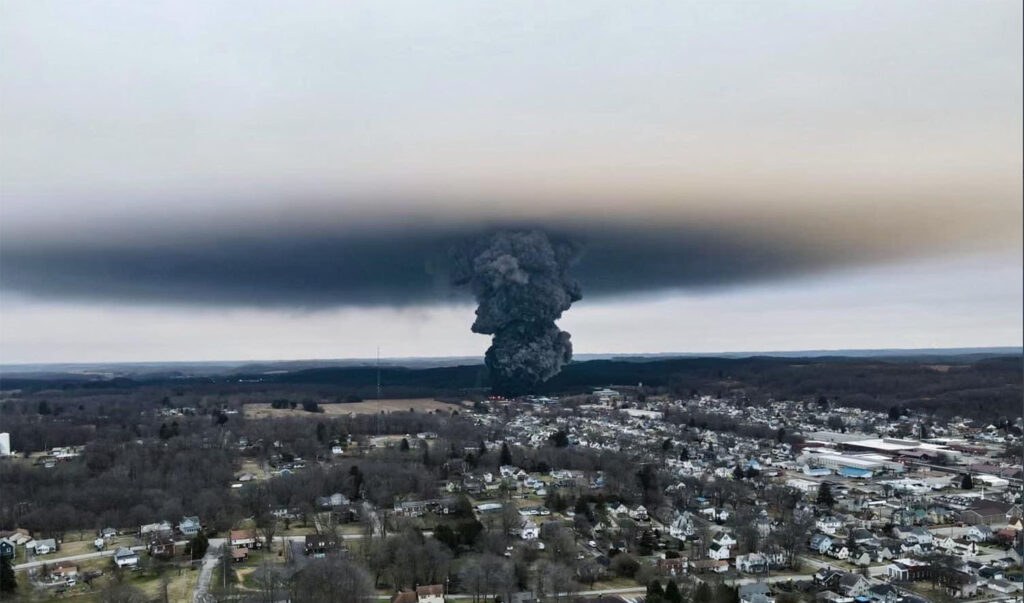By Terry Gips, Alliance President
We’ve been hearing a lot about the horrific impacts of the Palestine, Ohio train disaster, but there’s a far more toxic, large-scale and less visible trainwreck we have to confront. The primary hazardous chemical that spilled and caused the health and environmental nightmare was vinyl chloride, the building block for PVC. It literally touches every American in multiple ways, as well as the rest of the world. It’s a lose-lose-lose loser as an environmental, ubiquitous health, social justice, worker, consumer, community, climate and transportation threat.
Thanks to CBS News and the outstanding nonprofit Center for Environmental Health (CEH) for their excellent reporting on this: “Vinyl chloride entered the spotlight after the Feb. 3 Ohio train derailment. But the hazardous substance has been around for decades and is everywhere — from buildings and vehicle upholstery to children’s toys and kitchen supplies — and factories have been emitting the EPA-designated toxic chemical into the air for years.”
As the CBS piece continues: “The train that derailed had the manmade and volatile compound on board, prompting temporary evacuations amid concerns it could quickly impact people in the area. Then when officials decided to burn it, there were also concerns it could release phosgene, a gas that can be highly lethal and was used as a chemical weapon in WWI.”
“On Jan. 2, the U.S. Department of Health and Human Services published a draft toxicological profile for the substance. In it, experts say that the volatile compound, ‘used almost exclusively by the plastics industry,’ has ‘leached into groundwater from spills, landfills, and industrial sources,’ and that people who live around plastic manufacturing facilities ‘may be exposed to vinyl chloride by inhalation of contaminated air.’”
“This disaster is really a wakeup call,” Jimena Díaz Leiva, the science director for nonprofit Center for Environmental Health, told CBS News. “…There needs to be a lot more regulatory oversight and action to address not just the safety and the actual transport around these chemicals, but also just stemming our production of all these chemicals.”
The CEH published a report on polyvinyl chloride (PVC), a type of plastic used in pipes, buildings, packaging film, flooring and more, in 2018, saying, “the bottom line is there is no way to safely manufacture, use, or dispose of PVC products.”
As CBS points out, “The problem begins at vinyl chloride’s origins. It’s generated from ethane, which is obtained through fracking natural gas, a process that’s significantly grown since 2013 and when done, emits the greenhouse gas methane — a major driver of climate change. PVC, according to a 2020 study, has a “high potential in global warming than other plastics” due to its high energy consumption and CO2 emissions.”
“The U.S. Energy Information Administration said ethane production hit a monthly record last year of more than 2.4 million barrels per day. They expect production will hit 2.7 million barrels per day this year, as the global PVC market is expected to become a $56.1 billion industry within the next 3 years. A 2022 study also found that U.S. PVC production emitted roughly 18 million metric tons of CO2 in 2020.”
CBS points out that, “The emissions are known to have contributed to health issues in nearby communities. Mossville, Louisiana, a tiny town just west of Lake Charles that was founded by people who were formerly enslaved, has been historically plagued by manufacturing pollution. The area is surrounded by more than a dozen industrial facilities, including at least one working with vinyl chloride that has a history of violations and scores far above national and industry levels for factors contributing to health issues.”
“In 2021, the site was fined more than $447,000 for violations for failure to ensure performance, management safety, mechanical integrity and record keeping, among other things. The area is part of what’s known as ‘cancer alley’.”
As CEH’s Díaz Leiva says, “It’s a predominantly Black and Brown community. And a lot of the plastics manufacturing companies that are around there, these are the ones that are producing the same precursors that are getting us to PVC plastic and other types of plastics.”
Dr. Juliane Beier, assistant professor of medicine at Pittsburgh Liver Research Center and an expert who contributed to the DHHS report, told CBS News those most at-risk are occupational workers. But those in areas near PVC-producing factories could also face exposure: “We need to raise awareness that low levels of vinyl chloride that are currently considered safe may enhance underlying disease, this may be liver disease, but maybe also other disease…But this is, I think, an underestimated risk.”
Clearly, we have a lot of work to do. The Alliance has been speaking out and writing about this and other toxic chemical issues for years. We have testified regarding legislation and shared Take Actions to address reform of our toxics legislation. We hope you’ll join us.

